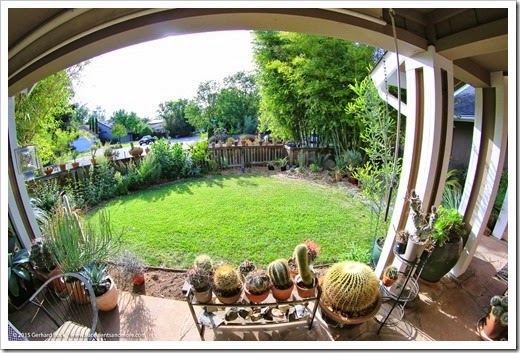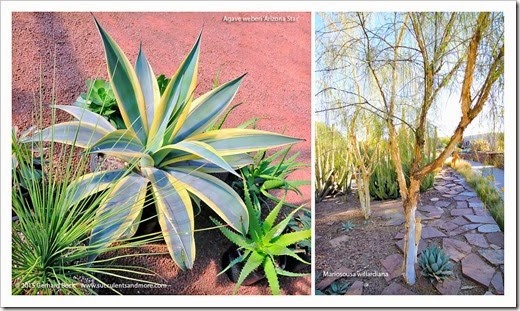The elephant in the room, a.k.a. our front lawn
As the drought in California and other parts of the western U.S. continues unabated, more and more homeowners are switching to water-wise landscaping. In our garden, we’ve been focusing on low-H₂O plants since the beginning so we haven’t had to swap out large swaths of plant material to accommodate the new normal. All planting strips and beds are on drip irrigation, which runs once a week for 20 minutes.
However, there’s a metaphorical elephant that stares you right in the face when you look at the following photos: the front lawn. At roughly 400 sq.ft. it isn’t huge and in previous years it was used regularly by our kids, but as yet another bone-dry summer approaches, it’s getting harder and harder to justify its existence. It, too, gets watered once a week for 20 minutes and is doing reasonably well on this new regimen. Yet I bet the lawn sprinklers running at full blast for 20 minutes put out much more water than a drip system would.
My wife and I have tentatively decided to remove the front lawn in the fall, but there are many things we’re not sure about yet. Should we turn off the sprinklers now and let the grass die over the summer? Would we want to look out on a 19×21 ft. brown patch for the next four or five months? Or should we continue to water it (other areas of the front yard are irrigated on the same station as the lawn)?
More importantly, what are we going to replace the lawn with? My first thought was to create a central mound and plant it with succulents—surprise! My wife, on the other hand, would like a couple of stock tanks for vegetables since the front lawn gets sun even in the winter when the vegetable garden in the backyard (fallow this summer) is in deep shade.
How can we combine the two so they don’t look like a particular unfortunate Lady Gaga outfit? Maybe create raised vegetable beds with low stacked-stone walls instead of using stock tanks? (I’m a big fan of stock tanks but they don’t look good in every situation.)
I definitely want a large agave as a central feature. I recently obtained a decent-sized offset from a variegated Weber agave (Agave weberi ‘Arizona Star’) that might be perfect here (the plant below is the mother, herself still a young ‘un). ‘Arizona Star’ has the potential to grow to 4 ft. tall and 6 ft. wide. Here is a specimen that gives you an idea of how beautiful this variety can be when well grown.
I envision it surrounded by rocks and smaller succulents, and possibly even backed by a slender and ethereal desert tree like palo blanco (Mariosousa willardiana, previously Acacia willardiana). The palo blanco would be planted behind the agave and vegetable bed so it doesn’t shade them.
I’m actually glad we have time to think about this instead of rushing into anything now in order to beat the summer heat. I’ll be able to re-read Lawn Gone! by Pam Penick and check out similar books. I’d much rather take my time in the fall when whatever plants we pick will have the opportunity to get established before next year’s summer heat.
I would love to hear what your thoughts are. What would you do if this were your front lawn? Let your imagination run wild!








Do both. Give her a small section for veggies and do another section for your succulents. 2 zones for watering.
ReplyDeleteFiguring out the irrigation will be tricky since the lawn is currently divided into two zones which also extend to other areas of the landscaping. Not the most logical way but that's what we're stuck with, at least for now.
DeleteIf you are letting it go in the fall anyway, why not just let it go now and save the water. This will give you time to think of the plan. Is all of that grass area full sun with no restrictions?
ReplyDeleteIt will be fun to do some paths leading you to a destination of either veggie garden and succulent garden.
The lawn gets full sun for 6-8 hours in the summer.
DeleteInteresting to hear your options with that space; looking forward to seeing what you do. I need to finish designing some spaces for other, but to start, planting up my big modern containers...now!
ReplyDeleteThat acacia changed names, too? Sheesh...Vachelia, Senegalia, etc...
Yep, the genus acacia has been "cleaned up" (as the experts claim). The Australian acacias keep the genus Acacia, and Central/South American and African acacias have completely new genera, including Mariosousa. Here's a good overview: http://waynesword.palomar.edu/plaug99.htm.
DeletePerhaps just water it this summer so it's green until you proceed with the changes? Low raised stone beds sounds great! Or perhaps make winding pathways between beds?
ReplyDeleteWe've decided to keep watering the lawn until we're reasonably sure of what we want. I'm still partial to low raised stone beds...
DeleteI think you could really make both work (veggies and monster agaves) but agree that stock tanks don't seem a great fit for your space (and you know I love me some stock tanks!). I would continue to water it for the summer, give yourself one last year of green. Twenty minutes once a week doesn't seem too crazy.
ReplyDeleteAfter much back and forth, stock tanks are back on the list as an option. Good think we've given ourselves a few months to mull this over...
DeleteOh and check out Ivette Soler's book too, she's a master at mixing the edibles and ornamentals: http://www.amazon.com/The-Edible-Front-Yard-Grow-More/dp/1604691999
ReplyDeleteJust requested it from the library. I gave a copy to friends years ago and remember liking what I read.
DeleteRaised beds with low stacked-stone walls sounds most excellent! Have you been following Emily Green's 'After the Lawn' series? Here's the final installment, with links to all the parts. Also: that ‘Arizona Star’ is gorgeous.
ReplyDeleteThank you for the recommendation! Emily's series is unbelievably thorough. It'll take me a while to work my way through it. So much valuable information!
DeleteDymondia Margaretae (Silver Carpet) was the best investment in time and money when we made our lawn conversion to drought tolerant. I used it for a nice wide path around new mounds of succulents. Best mulch ever - keeps the moisture in, weeds out and it's "tredible"! It grows fast and very easy to keep edges tidy.
ReplyDeleteI love Dymondia margaretae. We'll replace the tiny (tiny!) lawn in the backyard with it this fall, and I just planted a flat in the strip outside the front yard fence.
DeleteI'd get rid of that grass in a HEARTBEAT, Gerhard. Grass is a lot of work, a lot of expense and a lot of hassle to keep looking good. Let it die back like nature intended it to. I moved into my place 20 years ago and the first thing I did was rip out the grass. Maybe a little ornamental grass here and there, but no lawn. I love grass! When I want it I go to the park.
ReplyDeleteIt will be exciting to see what you & your wife come up with!
It's amazing how attached people are to their lawn. I didn't think I was one of them, but I'll admit that I'm wrestling with separation anxiety just a tiny bit, now that we've decided to get rid of the lawn.
DeleteWe took out our front lawn last year and I don't miss it at all. Except for an area around our Magnolia tree (under which nothing grew well and which we covered in bark mulch), I used a lot of Mediterranean plants, particularly Australian natives. (I'm in love with my Leptospermum 'Copper Glow.') I'm currently making plans to remove the last 2 unsightly patches of grass/weeds left on the property but most of those areas will be converted into stone pathways. In your case, I like the idea of mixing a beautiful specimen Agave with edibles in tiered stone planters. I'll enjoy seeing what you do!
ReplyDeleteI'll spend the summer collecting photos of projects I find inspiring. For once I'm glad we've decided to go slow.
DeleteMaybe multiple raised beds, some with veggies, some with xerics? I don't miss lawn at all.
ReplyDeleteYes, probably tiered beds of some sort unless we go the stock tank route. Not sure about that yet.
DeleteGerhard, I would draw a plan of the space as though it was all completely empty. What would you do if you had a blank state ? For example, with the nice enclosed area you have I would be tempted to enlarge the patio and create a path that would link the patio with the existing path. My plans are always more grandiose that my wallet ! Great suggestion from Loree about Ivette's book.
ReplyDeleteGreat idea, pretending nothing's there. There are some things in the planting strip along the fence I wouldn't want to be without, but other things I'd be willing to sacrifice.
DeleteI say do both. Strip the lawn out and dig it all out with machine. Wish I had.
ReplyDeleteI'll pay somebody to take out the lawn. I know what my limits are, LOL.
DeleteHow exciting! There's nothing like a new space to play with -- and all your options sound a lot more exciting, horticulturally, than lawn. If it were mine, I'd want to expand the porch space with a flagstone patio that extends to the driveway/front door area. True, that would take away some planting space, but it would also provide a sense of openness and usability that will be especially valuable once the lawn is gone. I'd also go ahead and dig out out the grass rather than keep watering it when you know its days are numbered. Summer is a great time to lay flagstone and prepare your new planting areas. Then you can start planting as soon as cooler weather arrives in fall.
ReplyDeleteAnd thanks, by the way, for mentioning my book! I hope it gives you some good ideas.
Pam/Digging: http://www.penick.net/digging
I have a schizophrenic relationship with design. The artist in me loves clean design, a limited plant palette repeated for maximum effect--what you see in books and design magazines. And yet the plant collector in me--that crazy, unruly anarchist--chomps at the bit to break free of design rules. All he wants is to fill every square inch with plants. It's hard to make the two get along!
DeleteI like Pam's idea. Having actually seen your property, I was thinking how nice it was to the eyes, that when entering thru your gate, to look across that wide expanse of less busy area. You have a lot going on already with all the pots and crammed borders, to add more would be nice in terms of more area to fill up (knowing you're a plant person), but design wise, not so nice. You could use flagstone or urbanite, and let the dymondia you already have fill the cracks. Sue
ReplyDeleteYou mean a more minimal approach? I wonder if I'd be able to pull that off. Maybe I should practice by putting a moratorium on new plant purchases?
DeleteI like Kathy and Pam's ideas, budget-busting tho they may be, reimaging the space as a whole. Maybe the veg raised beds close to the patio, with a walkable agave-land beckoning beyond...
ReplyDeleteBecause of the way our lot is situated, the veggie bed would have to be in the front, i.e. closest to the fence, with agave land and paths behind it so as not to shade the veggies.
Delete